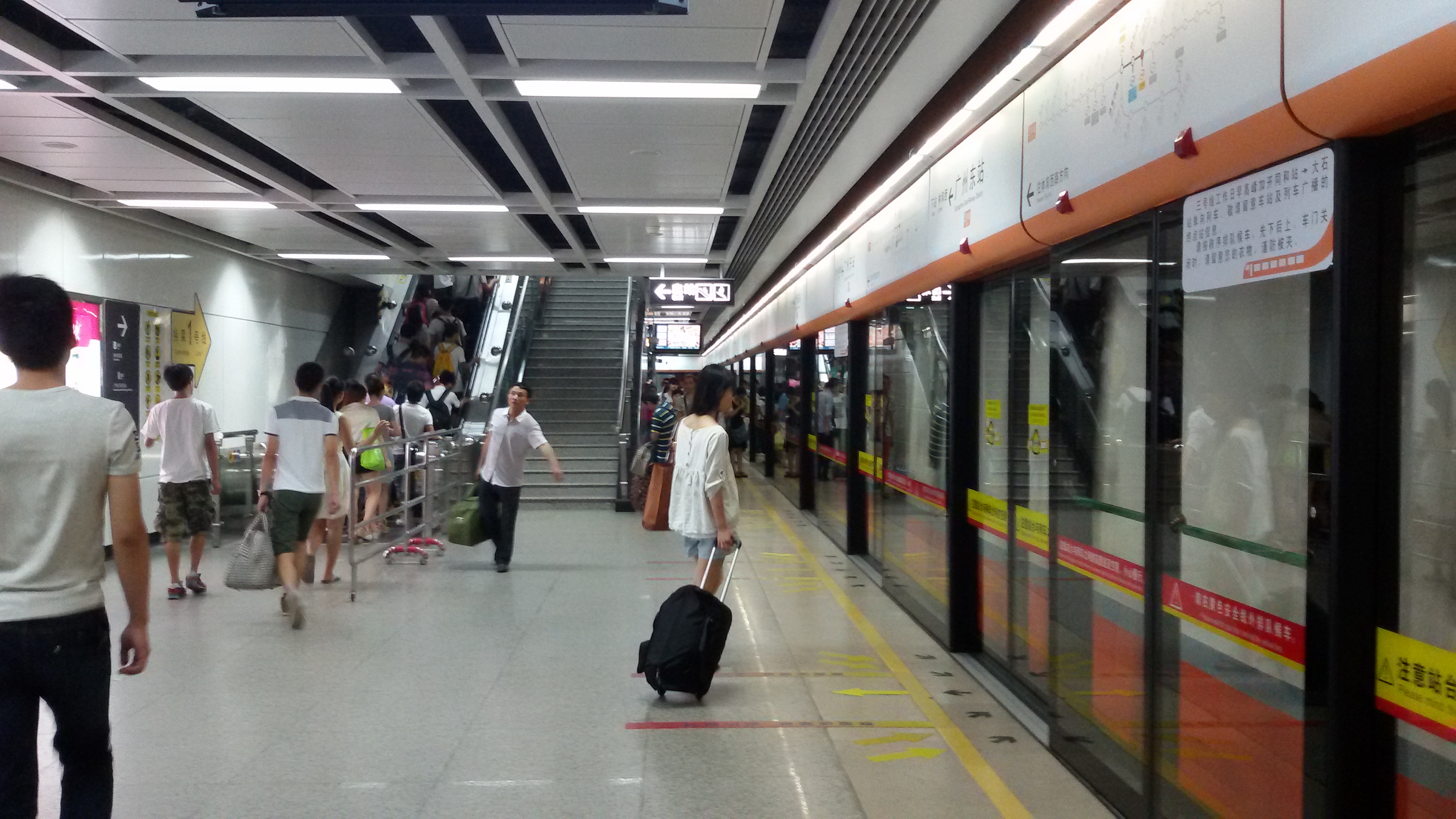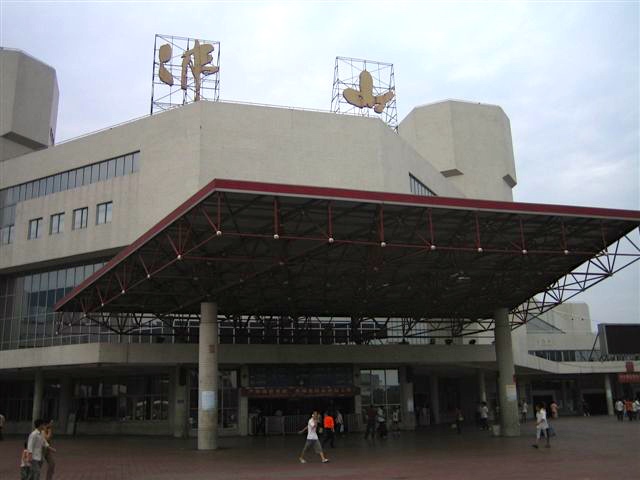|
Line 1, Guangzhou Metro
Line 1 of the Guangzhou Metro runs from to (). Apart from and Xilang, all stations in Line 1 are underground. The first section, from Xilang to Huangsha, opened on 28 June 1997, making Guangzhou the fourth city in mainland China to have a metro system. Construction took a total of 66 months. The total investment is 12.2616 billion yuan with an average cost per kilometer of 662.9 million yuan. The full line started operation on 28 June 1999. Line 1 is coloured yellow. Line 1 connects the old city on the north bank of the Pearl River and new development areas west of Tianhe District passing through many dense areas and important landmarks in central Guangzhou. At the same time, it also connects the newly built Guangzhou East Railway Station and Fangcun Passenger Station, two major transportation hubs. After the opening of the first section of the Guangfo Metro, it became a key corridor for traffic between the central urban areas of Guangzhou and neighboring Foshan. Therefore, aft ... [...More Info...] [...Related Items...] OR: [Wikipedia] [Google] [Baidu] |
Rapid Transit
Rapid transit or mass rapid transit (MRT), also known as heavy rail or metro, is a type of high-capacity public transport generally found in urban areas. A rapid transit system that primarily or traditionally runs below the surface may be called a subway, tube, or underground. Unlike buses or trams, rapid transit systems are railways (usually electric railway, electric) that operate on an exclusive right-of-way (transportation), right-of-way, which cannot be accessed by pedestrians or other vehicles, and which is often grade-separated in tunnels or on elevated railways. Modern services on rapid transit systems are provided on designated lines between rapid transit station, stations typically using electric multiple units on rail tracks, although some systems use guided rubber tires, magnetic levitation (''maglev''), or monorail. The stations typically have high platforms, without steps inside the trains, requiring custom-made trains in order to minimize gaps between train a ... [...More Info...] [...Related Items...] OR: [Wikipedia] [Google] [Baidu] |
Direct Current
Direct current (DC) is one-directional flow of electric charge. An electrochemical cell is a prime example of DC power. Direct current may flow through a conductor such as a wire, but can also flow through semiconductors, insulators, or even through a vacuum as in electron or ion beams. The electric current flows in a constant direction, distinguishing it from alternating current (AC). A term formerly used for this type of current was galvanic current. The abbreviations ''AC'' and ''DC'' are often used to mean simply ''alternating'' and ''direct'', as when they modify ''current'' or ''voltage''. Direct current may be converted from an alternating current supply by use of a rectifier, which contains electronic elements (usually) or electromechanical elements (historically) that allow current to flow only in one direction. Direct current may be converted into alternating current via an inverter. Direct current has many uses, from the charging of batteries to large power sup ... [...More Info...] [...Related Items...] OR: [Wikipedia] [Google] [Baidu] |
Guangzhou Metro Lines
Guangzhou (, ; ; or ; ), also known as Canton () and alternatively romanized as Kwongchow or Kwangchow, is the capital and largest city of Guangdong province in southern China. Located on the Pearl River about north-northwest of Hong Kong and north of Macau, Guangzhou has a history of over 2,200 years and was a major terminus of the maritime Silk Road; it continues to serve as a major port and transportation hub as well as being one of China's three largest cities. For a long time, the only Chinese port accessible to most foreign traders, Guangzhou was captured by the British during the First Opium War. No longer enjoying a monopoly after the war, it lost trade to other ports such as Hong Kong and Shanghai, but continued to serve as a major transshipment port. Due to a high urban population and large volumes of port traffic, Guangzhou is classified as a Large-Port Megacity, the largest type of port-city in the world. Due to worldwide travel restrictions at the beginning o ... [...More Info...] [...Related Items...] OR: [Wikipedia] [Google] [Baidu] |
Guangzhou East Railway Station
Guangzhoudong (Guangzhou East) railway station (), formerly known as Tianhe railway station () serves the city of Guangzhou, located in the city's Tianhe District. The railway, metro, and bus terminal stations is interconnected as a single station complex. There is an immigration check point within the station for Guangzhou–Kowloon through train passengers travelling to and from Hong Kong. Station Layout Rail services Rail services serving Guangzhou East railway station include: * Guangzhou–Shenzhen railway * Guangzhou–Kowloon through train * Guangzhou–Meizhou–Shantou railway Metro services An interchange station between Lines 1 and 3 of the Guangzhou Metro. It is located at the underground of China Railway station in Linhe Zhonglu (), Tianhe District Tianhe District () is one of the eleven districts of Guangzhou, the capital of Guangdong province. In Chinese, the name Tianhe literally means "a river in the sky/heavens", which is also a Chinese name f ... [...More Info...] [...Related Items...] OR: [Wikipedia] [Google] [Baidu] |
Guangzhou Bus Rapid Transit
Guangzhou Bus Rapid Transit (Guangzhou BRT or GBRT) is the bus rapid transit (BRT) system of the city of Guangzhou in the People's Republic of China. Its first line was put into operation on 10 February 2010. It handles approximately 1,000,000 passenger trips daily with a peak passenger flow of 26,900 pphpd (second only to the TransMilenio BRT system in Bogota, Colombia). In fact, this rapid transit system contains the world's longest BRT stations - around 260m including bridges - with bus volumes of 1 bus every 10 seconds or 350 per hour in a single direction. The BRT system has two new lines and two extensions planned. Fleet The BRT operates the following models of buses: * King Long XMQ6127G2 * King Long XMQ6180G2 * Youngman JNP6182LPG * Yutong ZK6120HGV * Yutong ZK6180HLGAA The livery of the BRT is orange with BRT written in white on the sides. Zhongshan Avenue Bus Rapid Transit Trial Line Zhongshan Avenue Bus Rapid Transit Trial Line () is the first and only line in ... [...More Info...] [...Related Items...] OR: [Wikipedia] [Google] [Baidu] |
LCD Map, Train 01x057-058, Guangzhou Metro
A liquid-crystal display (LCD) is a flat-panel display or other electronically modulated optical device that uses the light-modulating properties of liquid crystals combined with polarizers. Liquid crystals do not emit light directly but instead use a backlight or reflector to produce images in color or monochrome. LCDs are available to display arbitrary images (as in a general-purpose computer display) or fixed images with low information content, which can be displayed or hidden. For instance: preset words, digits, and seven-segment displays, as in a digital clock, are all good examples of devices with these displays. They use the same basic technology, except that arbitrary images are made from a matrix of small pixels, while other displays have larger elements. LCDs can either be normally on (positive) or off (negative), depending on the polarizer arrangement. For example, a character positive LCD with a backlight will have black lettering on a background that is the colo ... [...More Info...] [...Related Items...] OR: [Wikipedia] [Google] [Baidu] |
Platform Screen Doors
Platform screen doors (PSDs), also known as platform edge doors (PEDs), are used at some train, rapid transit and people mover stations to separate the platform from train tracks, as well as on some bus rapid transit, tram and light rail systems. Primarily used for passenger safety, they are a relatively new addition to many metro systems around the world, some having been retrofitted to established systems. They are widely used in newer Asian and European metro systems, and Latin American bus rapid transit systems. History The idea for platform edge doors dates as early as 1908, when Charles S. Shute of Boston was granted a patent for "Safety fence and gate for railway-platforms". The invention consisted of "a fence for railway platform edges", composed of a series of pickets bolted to the platform edge, and vertically movable pickets that could retract into a platform edge when there was a train in the station. In 1917, Carl Albert West was granted a patent for "Gate for s ... [...More Info...] [...Related Items...] OR: [Wikipedia] [Google] [Baidu] |
Foshan
Foshan (, ), alternately romanized as Fatshan, is a prefecture-level city in central Guangdong Province, China. The entire prefecture covers and had a population of 9,498,863 as of the 2020 census. The city is part of the western side of the Pearl River Delta Economic Zone whose built-up (or metro) area was home to 65,694,622 inhabitants as of 2020 (excluding Hong Kong not conurbated yet), making it the biggest urban area of the world. Foshan is regarded as the home of Cantonese opera, a genre of Chinese opera; Nanquan, a martial art; and lion dancing. Name ''Fóshān'' is the pinyin romanization of the city's Chinese name , based on its Mandarin pronunciation. The Postal Map spelling "Fatshan" derives from the same name's local Cantonese pronunciation. Other romanizations include Fat-shan and Fat-shun. Foshan means "BuddhaMountain" and, despite the more famous present-day statue of Guanyin (or Kwanyin) on Mount Xiqiao, who isn't a Buddha, it refers to a smaller hill n ... [...More Info...] [...Related Items...] OR: [Wikipedia] [Google] [Baidu] |
Guangfo Metro
The Guangfo Metro or Guangfo line is a intercity metro line that connects the Chinese cities Foshan and Guangzhou. As of December 2018, the line is currently long and has 25 stations, which are all underground. History The line was expected to start construction in 2002 with a tentative opening in 2009. However, due to capital shortage, its construction was claimed to be suspended until it resumed in 2007. The section between and was completed in 2010. The Xilang–Yangang section began operation on December 28, 2015. The section between and was completed in 2018. Since 24 April 2016, Wi-Fi Wi-Fi () is a family of wireless network protocols, based on the IEEE 802.11 family of standards, which are commonly used for local area networking of devices and Internet access, allowing nearby digital devices to exchange data by radio wave ... is available across the entire line. Future Development Guangzhou section The eastern extension from to Dashacundong is under plannin ... [...More Info...] [...Related Items...] OR: [Wikipedia] [Google] [Baidu] |
Overhead Lines
An overhead line or overhead wire is an electrical cable that is used to transmit electrical energy to electric locomotives, trolleybuses or trams. It is known variously as: * Overhead catenary * Overhead contact system (OCS) * Overhead equipment (OHE) * Overhead line equipment (OLE or OHLE) * Overhead lines (OHL) * Overhead wiring (OHW) * Traction wire * Trolley wire This article follows the International Union of Railways in using the generic term ''overhead line''. An overhead line consists of one or more wires (or rails, particularly in tunnels) situated over rail tracks, raised to a high electrical potential by connection to feeder stations at regular intervals. The feeder stations are usually fed from a high-voltage electrical grid. Overview Electric trains that collect their current from overhead lines use a device such as a pantograph, bow collector or trolley pole. It presses against the underside of the lowest overhead wire, the contact wire. Current collectors are ... [...More Info...] [...Related Items...] OR: [Wikipedia] [Google] [Baidu] |








.jpg)